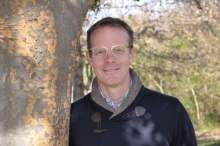CBE Seminar (Zoom): Polymers for Impact Mitigation - New Measurements Provide Insights into an Old Problem

Functional Polymers Group, Materials Science and Engineering Division
National Institute of Standards and Technology
Non-UCI people: Please use this registration link: https://forms.gle/6RrHDbPxGfjcwJ1q7
Abstract: Polymers are widely used in protective equipment or structures where the objective is to absorb or dissipate the energy from a mechanical impact. Examples include foams or gels incorporated into helmets, shear-thickening particle suspensions for stab-resistant body armor, high strength fibers woven into ballistic-resistant fabrics, and tough glassy polymers in structural armor for military and law enforcement vehicles. It is generally understood that there is a link between the molecular relaxations in a glassy polymer and its mechanical toughness. The notion is that these relaxations dissipate the energy imparted to the material during impact and thereby enhance toughness. Decades of research have focused on correlating the mechanical toughness of a polymer with the relaxation processes quantified by relatively slow characterization techniques, such as dynamic mechanical analysis, dielectric spectroscopy or solid-state nuclear magnetic resonance. However, there is a disconnect when it comes to understanding relaxations and impact resistance at the strain rates of 106 sec-1 or higher that are relevant for ballistic impact events. The time and length scale of the molecular mechanisms that are relevant for ballistic conditions are typically several orders of magnitude faster and more localized than the typical experimental techniques used by this community. We revisit these correlations between toughness and polymer relaxations by using quasielastic neutron scattering (QENS) to quantify the collective excitations and molecular relaxations that occur on the time scale of pico- to nanoseconds, and then see how these polymer motions correlate with mechanical toughness. What emerges is a strong correlation between the ratio of the population of the fast relaxations (dissipative) to the fast collective (many atom) vibrations deep in the glassy state and the mechanical toughness. We interpret this ratio as the number of successful relaxations per the vibrational attempt frequency and show a strong correlation between the number of successful relaxations and toughness. To explore these connections in greater detail, we are also developing a laser induced projectile impact testing (LIPIT) technique as a novel way to perform ballistic impact tests using micron scale particles at strain rates that exceed an inverse microsecond, a regime where most techniques capable of quantifying polymer relaxation spectra are too slow to be relevant.
Bio: Christopher L. Soles is a materials research engineer in the Materials Measurement Laboratory at the National Institute of Standards and Technology (NIST). Soles leads the Functional Polymers Group at NIST where he made significant contributions by developing measurement strategies to facilitate the use of polymeric materials in technologies that include semiconductor electronics, printed and flexible electronics, membranes for ion transport and water filtration, structural composites, and new materials for impact mitigation. His expertise in these areas focuses on elucidating the interplay between the structure, dynamics and processing of a polymeric material and how this in-turn affects the critical materials function that enables these technology sectors. He received bachelor of science degrees in both mechanical engineering (ME) and materials science and engineering (MSE) in 1993, and his doctorate in MSE in 1998, all from the University of Michigan. Go Blue! He came to the Polymers Division of NIST in 1999 as an NRC postdoctoral fellow and transitioned to a staff scientist in 2002. He has led the Functional Polymers Group at NIST since 2007. He has published over 150 peer-reviewed publications, received several prestigious awards, and was elected fellow of both the American Physical Society (2011) and the American Chemical Society (2016).
Host: Professor Albert Yee
